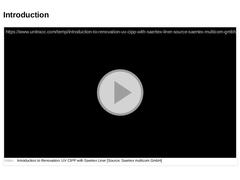
|
(Video: Introduction to Renovation: UV CIPP with Saertex Liner [Source: Saertex multicom GmbH]) |
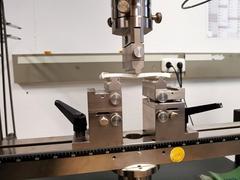
|
The renovation of sewers and pipelines with "Lining with cured-in-place pipes" is an assured standard construction method, starting with the planning process, through the production of materials, the installation, right up to checking the quality achieved. It is characterised by a wide range of applications and a high variance in the fabrication and application processes. This module teaches essential basics with regard to the required finishing work including the taking of samples, their testing for the acceptance of the rehabilitation performance and gives an overview of rehabilitation defects and their handling. This module requires knowledge of the modules “Lining with cured-in-place pipes - Basics” and " - Processes” as a prerequisite. After completion of this module, you will have a sound knowledge of: - procedures and process steps for connecting the CIPP liner to manholes and structures and lateral pipes;
- quality influences during installation and
- required tests for approving the professional installation of the CIPP liner.
|
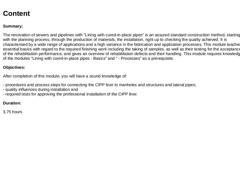
|
Summary: The renovation of sewers and pipelines with "Lining with cured-in-place pipes" is an assured standard construction method, starting with the planning process, through the production of materials, the installation, right up to checking the quality achieved. It is characterised by a wide range of applications and a high variance in the fabrication and application processes. This module teaches essential basics with regard to the required finishing … |
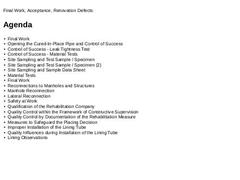
|
|
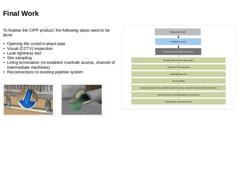
|
To finalise the CIPP product, the following steps need to be done: -
Opening the cured-in-place pipe
-
Visual (CCTV) inspection
-
Leak tightness test
-
Site sampling
-
Lining termination (re-establish manhole access, channel of intermediate manholes)
-
Reconnections to existing pipeline system
(Image: Insituform - Final Work) (Image: Insituform - Reconnection to existing system) (Image: Schematic procedure for the execution of lining with cured-in-place … |
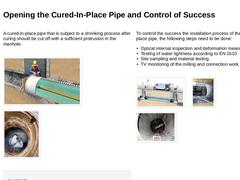
|
A cured-in-place pipe that is subject to a shrinking process after curing should be cut off with a sufficient protrusion in the manhole. (Image: Instituform - Opening (cut off) the cured lining tube in the arrival manhole) (Image: Opening (cut off) the cured lining tube in an intermediate manhole) To control the success the installation process of the cured-in-place pipe, the following steps need to be done: -
Optical internal inspection and deformation …
|
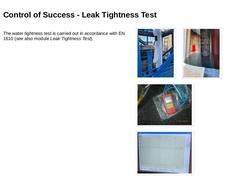
|
The water tightness test is carried out in accordance with EN 1610 (see also module Leak Tightness Test). (Image: Water tightness test of the cured CIPP liner with water – Opening of the inversion tube to establish the pressure head (0.5 bar)) (Image: Water tightness test of the cured CIPP liner with air – Arrow: indicated pressure head (0.5 bar)) (Image: Water tightness test of the cured CIPP liner with air – Measurement of the pressure loss by means … |
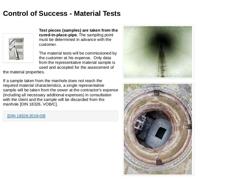
|
(Image: Picto Liste) Test pieces (samples) are taken from the cured-in-place-pipe. The sampling point must be determined in advance with the customer. The material tests will be commissioned by the customer at his expense. Only data from the representative material sample is used and accepted for the assessment of the material properties. If a sample taken from the manhole does not reach the required material characteristics, a single representative … |
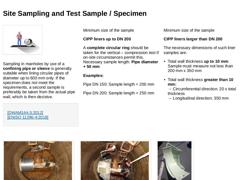
|
(Image: PICTO Not accessible / unmanned) Sampling in manholes by use of a confining pipe / sleeve / safety cap is generally suitable when lining circular pipes of diameter up to 600 mm only. If the specimen does not meet the requirements, a second sample is preferably be taken from the actual pipe wall, which is then decisive. [DWAM144-3:2012]
[ENISO 11296-4:2018] Minimum size of the sample CIPP liners up to DN 200 A complete circular ring should be taken … |

|
(Image: Picto Manned techniques / accessible) In the case of accessible cross-sections, the sample is preferably taken within the section. If the sewer to be rehabilitated has uneven surfaces (masonry, corrosion), the intended sampling point must be smoothed before installing the lining tube. The samples are to be removed from the CIPP liner in a thermally gentle manner (i.e. carefully avoiding local heating at the point of separation) … |

|
The test sample must be taken in the presence of the representatives of the customer and the contractor. The date and place of taking the sample as well as the procedure for closing the sampling point must be agreed with the client. At least one representative test sample shall be taken for each renovated section and labelled as follows: -
Site designation
-
Date the sample was collected
-
Manhole number
-
Section number
-
Signature of the representatives …
|
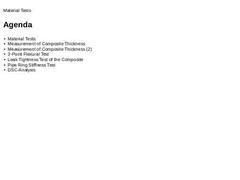
|
|
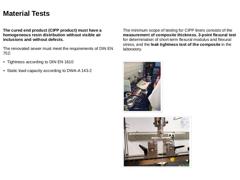
|
The cured end product (CIPP product) must have a homogeneous resin distribution without visible air inclusions and without defects. The renovated sewer must meet the requirements of EN 752: The minimum scope of testing for CIPP liners consists of the measurement of composite thickness, 3-point flexural test for determination of short-term flexural modulus and flexural stress, … |
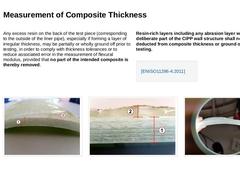
|
Any excess resin on the back of the test piece (corresponding to the outside of the liner pipe), especially if forming a layer of irregular thickness, may be partially or wholly ground off prior to testing, in order to comply with thickness tolerances or to reduce associated error in the measurement of flexural modulus, provided that no part of the intended composite is thereby removed. Resin-rich layers including any abrasion layer which are a deliberate … |
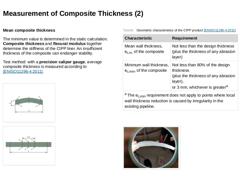
|
Mean composite thickness The minimum value is determined in the static calculation. Composite thickness and flexural modulus together determine the stiffness of the CIPP liner. An insufficient thickness of the composite can endanger stability. Test method: with a precision caliper gauge, average composite thickness is measured according to [ENISO11296-4:2011]. (Image: Cross-sectional shape of longitudinal test piece showing points for measurement of … |

|
|
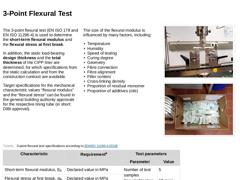
|
The 3-point flexural test (EN ISO 178 and EN ISO 11296-4) is used to determine the short-term flexural modulus and the flexural stress at first break. In addition, the static load-bearing design thickness and the total thickness of the CIPP liner are determined, for which specifications from the static calculation and from the construction contract are available. Target specifications for the mechanical characteristic values “flexural modulus” and … |
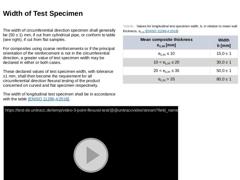
|
The width of circumferential direction specimen shall generally be (50 ± 1) mm, if cut from cylindrical pipe, or conform to table (see right), if cut from flat samples. For composites using coarse reinforcements or if the principal orientation of the reinforcement is not in the circumferential direction, a greater value of test specimen width may be declared in either or both cases. These declared values of test specimen width, with tolerance ±1 mm, … |
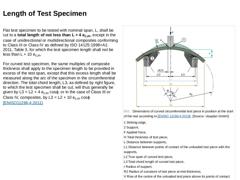
|
Flat test specimen to be tested with nominal span, L, shall be cut to a total length of not less than L + 4 ec,m, except in the case of unidirectional or multidirectional composites conforming to Class III or Class IV as defined by ISO 14125:1998+A1: 2011, Table 3, for which the test specimen length shall not be less than L + 10 ec,m. For curved test specimen, the same multiples of composite thickness shall apply to the specimen length to be provided … |
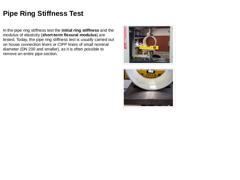
|
In the pipe ring stiffness test the initial ring stiffness and the modulus of elasticity (short-term flexural modulus) are tested. Today, the pipe ring stiffness test is usually carried out on house connection liners or CIPP liners of small nominal diameter (DN 200 and smaller), as it is often possible to remove an entire pipe section. (Image: Pipe Ring Stiffness Testing Machine – Pipe ring stiffness test on a CIPP segment) (Image: Pipe ring stiffness … |
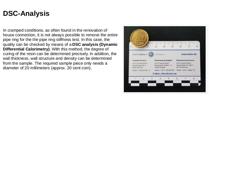
|
In cramped conditions, as often found in the renovation of house connection, it is not always possible to remove the entire pipe ring for the the pipe ring stiffness test. In this case, the quality can be checked by means of a DSC analysis (Dynamic Differential Calorimetry). With this method, the degree of curing of the resin can be determined precisely. In addition, the wall thickness, wall structure and density can be determined from the sample. … |

|
-
The annular gap between the manhole or the host pipe and the CIPP liner must be permanently sealed along all cut edges.
-
The cut edges of the composite are to be treated in such a way that they are not exposed to the effluent in the pipe or to ground water [ENISO11296-4:2011].
-
In principle, the reconnections to existing pipeline system (manhole and lateral reconnection) may only be carried out after the thermal expansion process the cured lining …
|
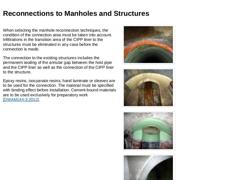
|
When selecting the manhole reconnection techniques, the condition of the connection area must be taken into account. Infiltrations in the transition area of the CIPP liner to the structures must be eliminated in any case before the connection is made. The connection to the existing structures includes the permanent sealing of the annular gap between the host pipe and the CIPP liner as well as the connection of the CIPP liner to the structure. Epoxy … |
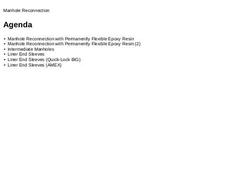
|
|
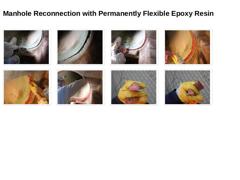
|
(Image: Manhole reconnection with permanently flexible epoxy resin - Preparation of the annular gap between liner and manhole wall) (Image: Manhole reconnection with permanently flexible epoxy resin - Annular gap between liner and manhole wall) (Image: Manhole reconnection with permanently flexible epoxy resin - Filling the annular gap with permanently flexible epoxy resin (here resin8)) (Image: Manhole reconnection with permanently flexible epoxy … |